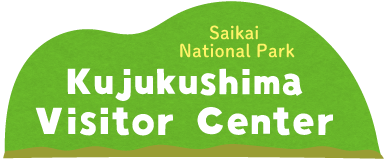The Ecology of Kujukushima
Many of Kujukushima’s islands are covered with lush greenery and trees, which makes for a dramatic contrast with the blue sea. As the islands are located in the warm-temperate zone, temperatures drop during the winter, and the deciduous trees lose their foliage; the coniferous trees, which make up the majority of the trees on the islands, drop their needles in April or May. These fallen leaves and other plant material slowly decompose and form rich new soil.
In the coastal areas of Kujukushima, the Sazagawa River, the Ainouragawa River, and other rivers carry nutrient-rich waters from the forests into the ocean, sustaining a wide range of ocean life.
In the coastal areas of Kujukushima, the Sazagawa River, the Ainouragawa River, and other rivers carry nutrient-rich waters from the forests into the ocean, sustaining a wide range of ocean life.
<ISLAND/WATER FLOW ILLUSTRATION>
0,Humus: nutrient-rich soil
1,Water running under the surface of the soil carries with it large amounts of nutrients
2,The waterborne nutrients become food for water plants and plankton
3,Small fish, crustaceans, and other animals feed on the plants and plankton
4,Small animals are eaten by larger fish and other animals
1,Water running under the surface of the soil carries with it large amounts of nutrients
2,The waterborne nutrients become food for water plants and plankton
3,Small fish, crustaceans, and other animals feed on the plants and plankton
4,Small animals are eaten by larger fish and other animals
From the audio:
5,Rocky Shores
Some of the Kujukushima shorelines are made up of rock and stones. These are the habitat of sea anemones, barnacles, and other creatures, and a refuge for small fish and shellfish. Tide pools where small fish and crustaceans remain when the tide recedes are great places to observe nature.
6,Islands and Plants
On beaches where there is shelter from the wind, plants such as the kanoko yuri lily and hamabo yellow hibiscus flourish. In more exposed locations, Japanese black pines (kuro matsu), tall sudaji (Castanopsis sieboldii) and Japanese bayberry (yamamomo) have adapted to the strong ocean breezes. In places where the wind is strongest, only black pines can survive.
7,Intertidal Zone
The area where sand and mud mix as tides flow in and out is known as the intertidal zone. Due to revetment construction and land reclamation projects, the number of intertidal zones across Japan has dropped dramatically. In Kujukushima, these important zones are protected in order to maintain biodiversity. It is the habitat of animals like mudskippers (tobihaze) and horseshoe crabs, known as kabuto-gani or “samurai helmet” crabs.
8,Sand Beaches
Small sandy beaches abound around Kujukushima. While visitors might think they have the beaches all to themselves, they are actually sharing it with ghost crabs (sunagani) and sand-bubbler crabs (kometsuki-gani). The crabs eat the plankton that comes in with the tides, while at low tide grey herons (aosagi) and racoon dogs (tanuki) come to hunt the crabs themselves.
9,Islands and the Ocean
On the islands, leaves fall from the trees and decompose, turning into nutrient-rich humus. This rich soil provides nutrition for the trees on these otherwise nutrient-poor islands. In Kujukushima, the trees along the shoreline stretch their branches out over the surface of the sea. This creates shadowed areas along the shoreline, an ideal habitat for rare shellfish, coastal water striders and fish that prefer being in the shade.

















